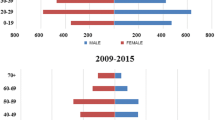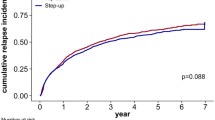Abstract
Background
With the introduction of anti-TNF therapies in the treatment of IBD, the therapeutic strategies have changed to an accelerated step-up care to avoid long-term complications. Little is known about the implementation of these strategies into daily care. We aimed to evaluate this question and to identify factors associated with the early use of immunosuppressants or anti-TNF therapies in a population-based IBD cohort.
Methods
Patients with an IBD diagnosed between January 2004 and December 2008 were included. Medical therapies were evaluated at first diagnosis and during a 5-year follow-up. Risk factors associated with the initiation of an immunosuppressive therapy were assessed.
Results
Two hundred and forty-one patients were evaluated (145 Crohn’s disease (CD), 96 ulcerative colitis (UC)). An immunosuppressive or anti-TNF therapy was started in 83 CD (57.2 %) and 40 UC (43 %) patients (p = 0.033, relative risks (RR) 1.77; 95 % confidence interval (CI) 1.05–3.0). After 5 years, 38.8 % CD patients on immunosuppressive therapy were treated with anti-TNF therapies. The use of corticosteroids at first diagnosis, disease localization and surgery were independent predictors for an immunosuppressive or anti-TNF therapy in CD. In UC, the extension of disease was associated with immunosuppressive therapies. The use of steroids and localization in CD patients and an extended disease in UC patients affected the time until an immunosuppressive therapy was started.
Conclusion
We found a high proportion of patients using an immunosuppressive therapy during the early course. Therefore, the accelerated step-up strategy seems to be successfully implemented in the daily care of IBD patients. We were able to identify several factors associated with an immunosuppressive or anti-TNF therapy in CD and UC.


Similar content being viewed by others
References
Cosnes J, Gower-Rousseau C, Seksik P, Cortot A (2011) Epidemiology and natural history of inflammatory bowel diseases. Gastroenterology 140(6):1785–1794
Hanauer SB, Present DH (2003) The state of the art in the management of inflammatory bowel disease. Rev Gastroenterol Disord 3(2):81–92
Lowenberg M, D’Haens G (2012) Mucosal healing in Crohn’s disease: relevance for clinical outcomes. Curr Drug Targets 13(10):1248–1251
Baert F, Moortgat L, Van Assche G, Caenepeel P, Vergauwe P, De Vos M, Stokkers P, Hommes D, Rutgeerts P, Vermeire S et al.(2010) Mucosal healing predicts sustained clinical remission in patients with early-stage Crohn’s disease. Gastroenterology, 138(2):463–468; quiz e410-461.
Panaccione R, Rutgeerts P, Sandborn WJ, Feagan B, Schreiber S, Ghosh S (2008) Review article: treatment algorithms to maximize remission and minimize corticosteroid dependence in patients with inflammatory bowel disease. Aliment Pharmacol Ther 28(6):674–688
Rutgeerts P, Sandborn WJ, Feagan BG, Reinisch W, Olson A, Johanns J, Travers S, Rachmilewitz D, Hanauer SB, Lichtenstein GR et al (2005) Infliximab for induction and maintenance therapy for ulcerative colitis. N Engl J Med 353(23):2462–2476
Hanauer SB, Feagan BG, Lichtenstein GR, Mayer LF, Schreiber S, Colombel JF, Rachmilewitz D, Wolf DC, Olson A, Bao W et al (2002) Maintenance infliximab for Crohn’s disease: the ACCENT I randomised trial. Lancet 359(9317):1541–1549
Colombel JF, Sandborn WJ, Rutgeerts P, Enns R, Hanauer SB, Panaccione R, Schreiber S, Byczkowski D, Li J, Kent JD et al (2007) Adalimumab for maintenance of clinical response and remission in patients with Crohn’s disease: the CHARM trial. Gastroenterology 132(1):52–65
Schreiber S, Reinisch W, Colombel JF, Sandborn WJ, Hommes DW, Robinson AM, Huang B, Lomax KG, Pollack PF (2013) Subgroup analysis of the placebo-controlled CHARM trial: increased remission rates through 3 years for adalimumab-treated patients with early Crohn’s disease. J Crohn’s Colitis 7(3):213–221
Schreiber S, Colombel JF, Bloomfield R, Nikolaus S, Scholmerich J, Panes J, Sandborn WJ (2010) Increased response and remission rates in short-duration Crohn’s disease with subcutaneous certolizumab pegol: an analysis of PRECiSE 2 randomized maintenance trial data. Am J Gastroenterol 105(7):1574–1582
D’Haens G, Baert F, van Assche G, Caenepeel P, Vergauwe P, Tuynman H, De Vos M, van Deventer S, Stitt L, Donner A et al (2008) Early combined immunosuppression or conventional management in patients with newly diagnosed Crohn’s disease: an open randomised trial. Lancet 371(9613):660–667
Solberg IC, Lygren I, Jahnsen J, Aadland E, Hoie O, Cvancarova M, Bernklev T, Henriksen M, Sauar J, Vatn MH et al (2009) Clinical course during the first 10 years of ulcerative colitis: results from a population-based inception cohort (IBSEN Study). Scand J Gastroenterol 44(4):431–440
Solberg IC, Vatn MH, Hoie O, Stray N, Sauar J, Jahnsen J, Moum B, Lygren I (2007) Clinical course in Crohn’s disease: results of a Norwegian population-based ten-year follow-up study. Clin Gastroenterol Hepatol 5(12):1430–1438
Cosnes J, Bourrier A, Nion-Larmurier I, Sokol H, Beaugerie L, Seksik P (2012) Factors affecting outcomes in Crohn’s disease over 15 years. Gut 61(8):1140–1145
Burger D, Travis S (2011) Conventional medical management of inflammatory bowel disease. Gastroenterology, 140(6):1827–1837 e1822.
Sands BE (2012) The risks and benefits of early immunosuppression and biological therapy. Dig Dis 30(Suppl 3):100–106
Ordas I, Feagan BG, Sandborn WJ (2011) Early use of immunosuppressives or TNF antagonists for the treatment of Crohn’s disease: time for a change. Gut 60(12):1754–1763
Beaugerie L, Seksik P, Nion-Larmurier I, Gendre JP, Cosnes J (2006) Predictors of Crohn’s disease. Gastroenterology 130(3):650–656
Lakatos PL, Czegledi Z, Szamosi T, Banai J, David G, Zsigmond F, Pandur T, Erdelyi Z, Gemela O, Papp J et al (2009) Perianal disease, small bowel disease, smoking, prior steroid or early azathioprine/biological therapy are predictors of disease behavior change in patients with Crohn’s disease. World J Gastroenterol 15(28):3504–3510
Loly C, Belaiche J, Louis E (2008) Predictors of severe Crohn’s disease. Scand J Gastroenterol 43(8):948–954
Romberg-Camps MJ, Dagnelie PC, Kester AD, de Kruijs MA H-v, Cilissen M, Engels LG, Van Deursen C, Hameeteman WH, Wolters FL, Russel MG et al (2009) Influence of phenotype at diagnosis and of other potential prognostic factors on the course of inflammatory bowel disease. Am J Gastroenterol 104(2):371–383
Wolters FL, Russel MG, Sijbrandij J, Ambergen T, Odes S, Riis L, Langholz E, Politi P, Qasim A, Koutroubakis I et al (2006) Phenotype at diagnosis predicts recurrence rates in Crohn’s disease. Gut 55(8):1124–1130
Thia KT, Sandborn WJ, Harmsen WS, Zinsmeister AR, Loftus EV Jr (2010) Risk factors associated with progression to intestinal complications of Crohn’s disease in a population-based cohort. Gastroenterology 139(4):1147–1155
Roth LS, Chande N, Ponich T, Roth ML, Gregor J (2010) Predictors of disease severity in ulcerative colitis patients from Southwestern Ontario. World J Gastroenterol 16(2):232–236
Hoie O, Wolters F, Riis L, Aamodt G, Solberg C, Bernklev T, Odes S, Mouzas IA, Beltrami M, Langholz E et al (2007) Ulcerative colitis: patient characteristics may predict 10-yr disease recurrence in a European-wide population-based cohort. Am J Gastroenterol 102(8):1692–1701
Ott C, Obermeier F, Thieler S, Kemptner D, Bauer A, Scholmerich J, Rogler G, Timmer A (2008) The incidence of inflammatory bowel disease in a rural region of Southern Germany: a prospective population-based study. Eur J Gastroenterol Hepatol 20(9):917–923
Gasche C, Scholmerich J, Brynskov J, D’Haens G, Hanauer SB, Irvine EJ, Jewell DP, Rachmilewitz D, Sachar DB, Sandborn WJ et al (2000) A simple classification of Crohn’s disease: report of the Working Party for the World Congresses of Gastroenterology, Vienna 1998. Inflamm Bowel Dis 6(1):8–15
Dignass A, Lindsay JO, Sturm A, Windsor A, Colombel JF, Allez M, D’Haens G, D’Hoore A, Mantzaris G, Novacek G et al (2012) Second European evidence-based consensus on the diagnosis and management of ulcerative colitis part 2: current management. J Crohn’s Colitis 6(10):991–1030
Dignass A, Preiss JC, Aust DE, Autschbach F, Ballauff A, Barretton G, Bokemeyer B, Fichtner-Feigl S, Hagel S, Herrlinger KR et al (2011) Updated German guideline on diagnosis and treatment of ulcerative colitis, 2011. Z Gastroenterol 49(9):1276–1341
Dignass A, Van Assche G, Lindsay JO, Lemann M, Soderholm J, Colombel JF, Danese S, D’Hoore A, Gassull M, Gomollon F et al (2010) The second European evidence-based Consensus on the diagnosis and management of Crohn’s disease: current management. J Crohn’s Colitis 4(1):28–62
Hoffmann JC, Preiss JC, Autschbach F, Buhr HJ, Hauser W, Herrlinger K, Hohne W, Koletzko S, Krieglstein CF, Kruis W et al (2008) Clinical practice guideline on diagnosis and treatment of Crohn’s disease. Z Gastroenterol 46(9):1094–1146
Lakatos PL, Golovics PA, David G, Pandur T, Erdelyi Z, Horvath A, Mester G, Balogh M, Szipocs I, Molnar C et al (2012) Has there been a change in the natural history of Crohn’s disease? Surgical rates and medical management in a population-based inception cohort from Western Hungary between 1977–2009. Am J Gastroenterol 107(4):579–588
Jess T, Riis L, Vind I, Winther KV, Borg S, Binder V, Langholz E, Thomsen OO, Munkholm P (2007) Changes in clinical characteristics, course, and prognosis of inflammatory bowel disease during the last 5 decades: a population-based study from Copenhagen, Denmark. Inflamm Bowel Dis 13(4):481–489
Mossop H, Davies P, Murphy MS (2008) Predicting the need for azathioprine at first presentation in children with inflammatory bowel disease. J Pediatr Gastroenterol Nutr 47(2):123–129
Chow DK, Sung JJ, Wu JC, Tsoi KK, Leong RW, Chan FK (2009) Upper gastrointestinal tract phenotype of Crohn’s disease is associated with early surgery and further hospitalization. Inflamm Bowel Dis 15(4):551–557
Lau A, Chande N, Ponich T, Gregor JC (2008) Predictive factors associated with immunosuppressive agent use in ulcerative colitis: a case-control study. Aliment Pharmacol Ther 28(5):606–613
Szamosi T, Banai J, Lakatos L, Czegledi Z, David G, Zsigmond F, Pandur T, Erdelyi Z, Gemela O, Papp M et al (2010) Early azathioprine/biological therapy is associated with decreased risk for first surgery and delays time to surgery but not reoperation in both smokers and nonsmokers with Crohn’s disease, while smoking decreases the risk of colectomy in ulcerative colitis. Eur J Gastroenterol Hepatol 22(7):872–879
Rubin DT, Uluscu O, Sederman R (2012) Response to biologic therapy in Crohn’s disease is improved with early treatment: an analysis of health claims data. Inflamm Bowel Dis 18(12):2225–2231
Conflict of interest
Claudia Ott has served as a speaker for AbbVie, Dr. Falk Pharma and MSD. She has received funding from the “Gesellschaft für Gastroenterologie in Bayern” in 2006.
Funding
Nothing to declare.
Authors’ contributions
CO contributed to the conception and design of the study, acquisition of data and writing of the manuscript. AT contributed to the acquisition of data and administering of all data. FO and ES contributed to the acquisition of data and editing the manuscript. BS performed the statistical analysis. MM edited and revised the manuscript. All authors read and approved the final manuscript.
Author information
Authors and Affiliations
Corresponding author
Rights and permissions
About this article
Cite this article
Ott, C., Takses, A., Obermeier, F. et al. How fast up the ladder? Factors associated with immunosuppressive or anti-TNF therapies in IBD patients at early stages: results from a population-based cohort. Int J Colorectal Dis 29, 1329–1338 (2014). https://doi.org/10.1007/s00384-014-2002-z
Accepted:
Published:
Issue Date:
DOI: https://doi.org/10.1007/s00384-014-2002-z




